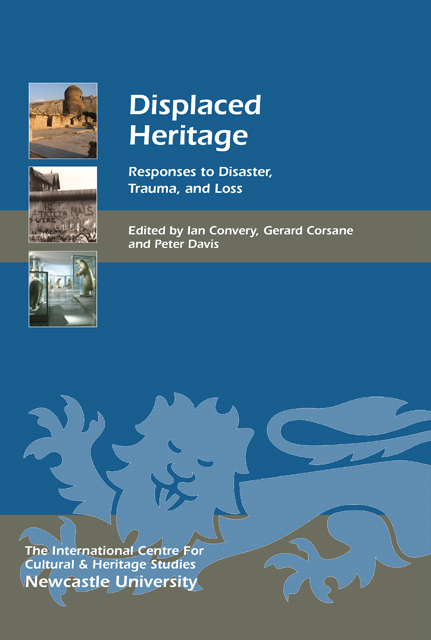Book contents
- Frontmatter
- Contents
- List of Illustrations
- Acknowledgments
- List of Abbreviations
- Preface
- Introduction
- Displaced Heritage: Histories and Tourism
- Displaced Heritage: Trauma, Confinement and Loss
- Displaced Heritage: Lived Realities, Local Experiences
- Displaced Natural Heritage
- Endpiece
- List of Contributors
- Index
- Heritage Matters
19 - Village Heritage and Resilience in Damaging Floods and Debris Flows, Kullu Valley, Indian Himalaya
Published online by Cambridge University Press: 24 February 2023
- Frontmatter
- Contents
- List of Illustrations
- Acknowledgments
- List of Abbreviations
- Preface
- Introduction
- Displaced Heritage: Histories and Tourism
- Displaced Heritage: Trauma, Confinement and Loss
- Displaced Heritage: Lived Realities, Local Experiences
- Displaced Natural Heritage
- Endpiece
- List of Contributors
- Index
- Heritage Matters
Summary
Introduction
Heritage is shaped, and reshaped, by the impacts of natural hazard events that are common in mountains. This chapter examines the heritage–resilience relationship through villages in the Phojal Nalla catchment, in the Kullu Valley of the Indian Himalaya (see Fig 19.1) in the context of a 1994 flood event. The Valley is rich in many forms of heritage, including vernacular architecture, material culture, and custom and religion.
Current definitions of heritage are complex and disputed; nonetheless, understandings are drawn from Smith (2006), Sorenson and Carman (2009) and Harrison (2013), where heritage may comprise: (1) objects, places and societal practices; (2) tangible (ie objects) and intangible (ie socio-cultural practices) contributors; (3) officially recognised and unofficial contributors; and (4) an entity that is intertwined and continually created. Of these, intangible heritage is particularly relevant, since it sees people as unofficial heritage creators through their thoughts, knowledge and approaches to life. This type of cultural heritage may arise in response to actual loss and perceived risk, enabling the past to inform understanding of, and engagement with, the present and the future. Intangible heritage can take many forms: art, dance, food, language, music, oral histories, religion and virtual media.
It may seem somewhat unusual to be discussing heritage and resilience together in relation to flood events, but heritage is an important resource that can contribute significantly to strengthening community resilience. The definition and utility of the resilience concept has been heavily debated (Cutter et al 2008; Brown 2014). In the context of communities subject to hazards, it is frequently discussed in association with societal vulnerability (a potential for harm). Resilience is often seen as a positive condition, opposite yet interlinked to vulnerability – a negative condition. Cutter et al (2008, 599) define resilience as:
the ability of a social system to respond and recover from disasters and includes those inherent conditions that allow the system to absorb impacts and cope with an event, as well as postevent, adaptive processes that facilitate the ability of the social system to re-organise, change, and learn in response to a threat.
To improve community resilience, an understanding of contributing factors is necessary. Capital is key in developing and maintaining resilience where economic, social and environmental resources facilitate coping (during event) and adaptation (after event).
- Type
- Chapter
- Information
- Displaced HeritageResponses to Disaster, Trauma, and Loss, pp. 207 - 224Publisher: Boydell & BrewerPrint publication year: 2014
- 1
- Cited by



